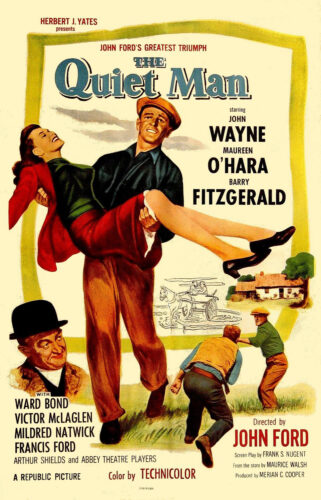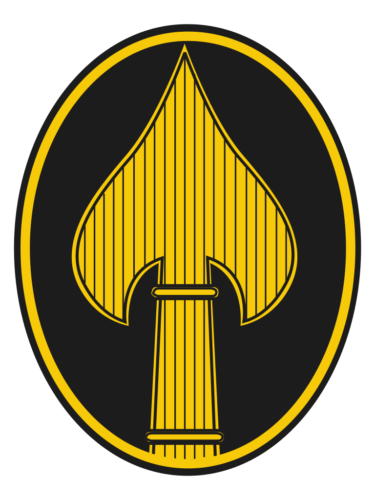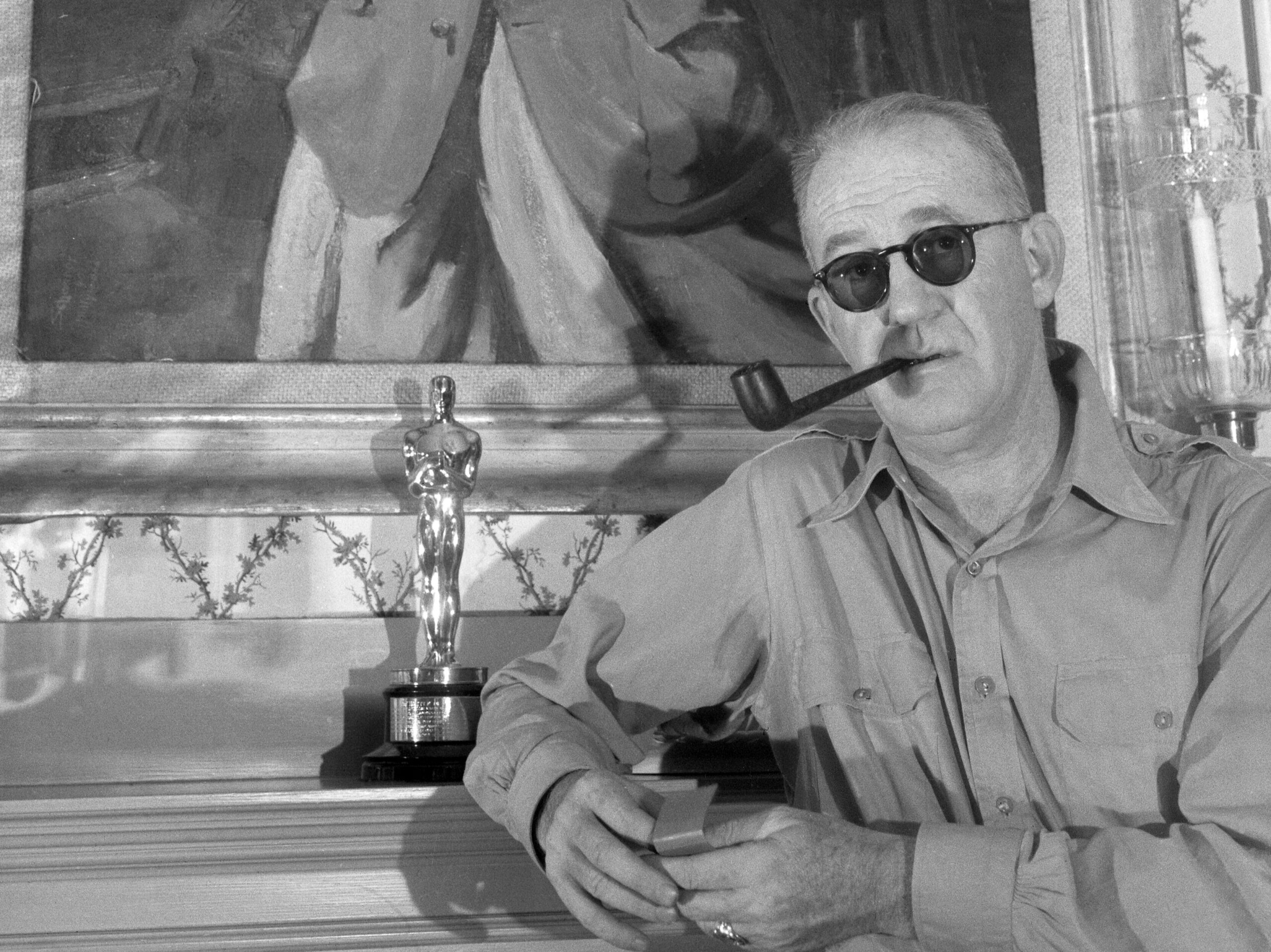John Ford with Oscar® statuette, circa 1946.
He is the essence of classical American cinema. Any serious person making films today, whether they know it or not, is affected by Ford.” — Martin Scorsese
John Martin Feeney, known professionally as John Ford, was born on February 1, 1894, in Cape Elizabeth, Maine. He was one of the most important and influential filmmakers of his generation. Ford made frequent use of location shooting and wide shots, in which his characters were framed against a vast, harsh, and rugged natural terrain. He received six Academy Awards including a record four wins for Best Director for his work on The Informer (1935), The Grapes of Wrath (1940), How Green Was My Valley (1941), and The Quiet Man (1952).

OSS Field Photographic Branch.
Ford played a significant role in the creation and operation of the Office of Strategic Services (OSS) Field Photographic Branch (FPB). In the early 1930s, Ford, who was a reservist in the Navy, created a unit of cameramen to intervene “in case of emergency”. By 1939, the Field Photographic Section of the 11th Naval District became operational. A few weeks before the attack on Pearl Harbor, Ford announced that he had trained around sixty technicians.
When the OSS was established in 1942, Ford’s unit became part of it, marking the beginning of the OSS Field Photographic Branch (FPB). The FPB was responsible for producing films that provided valuable intelligence and historical records of World War II. The OSS was the Word War II predecessor to the Central Intelligence Agency (CIA).
The work of the FPB played a significant role in the Allied victory in World War II. The films they produced not only provided valuable intelligence but also serve as a lasting record of the events of the war. Their work continues to be a valuable resource for historians and researchers studying this period.

John Ford’s Role
Ford was in charge of 56 US Coast Guard combat photographers and automated cameras mounted on landing craft during the Normandy landings and Battle of Normandy in summer 1944. His team shot “millions of feet” in both color and black-and-white, but “mostly Kodachrome” (color), including near Colleville-sur-Mer. The film was shipped back to the UK and edited in London by a team working 24-hours-a-day in shifts, four hours on, four hours off.
Some of Ford’s footage was included in a documentary film that was shown to Allied leaders of World War II, namely British Prime Minister Winston Churchill, Supreme Allied Commander Dwight Eisenhower, Canadian Prime Minister Mackenzie King, US President Franklin D. Roosevelt, and Soviet dictator Marshall Josef Stalin.
During World War II, John Ford also directed several documentaries. Two of these, The Battle of Midway (1942) and December 7th (1943), won Academy Awards for Best Documentary and Documentary Short Subject, respectively. He was awarded the Purple Heart for shrapnel wounds received during the Battle of Midway. He was knocked out by the force of an explosion while recording the action on 16mm Kodachrome. For his military service during World War II, Ford was also awarded the Legion of Merit with Combat “V”, the Meritorious Service Medal, and the Air Medal.

Ford also made a groundbreaking training film for the OSS — Undercover: How to Operate Behind Enemy Lines (1943). Directed by and featuring Ford, it was edited by Robert Parrish, a frequent collaborator of Ford’s. The film, which was Ford’s only sound film acting role, was the first film ever produced by an intelligence service to train its agents. The film is structured as a docudrama that dramatizes the experiences of OSS agents to teach them the right and wrong way of comporting themselves in the field. Now in the public domain, the film is widely accessible online since its declassification post-war. However, it is often overlooked in discussions of Ford’s filmography.
After being released from active duty, he returned to Hollywood to make They Were Expendable (1945), The film, directed by Ford, stars Robert Montgomery and John Wayne, with Donna Reed also featuring, is an adaptation of the 1942 novel by William Lindsay White. It tells the tale of Motor Torpedo Boat Squadron Three, a PT boat unit from the United States. During World War II, they defended the Philippines from a Japanese invasion in the Battle of the Philippines (1941–42).
Ford’s expertise in filmmaking and his leadership in the FPB played a crucial role in documenting the events of World War II. His work not only served as valuable intelligence for the Allied forces but also as historical records that continue to educate and inform us about the realities of the war. Ford’s affiliation with the Navy extended beyond World War II, and he rose to the rank of rear admiral in the US Naval Reserve.
Ford’s contributions to the film industry were further recognized with a star on the Hollywood Walk of Fame. His star, awarded in 1960, is located at 1640 Vine Street. In 1972, the Western Heritage Awards honored Ford with the Trustees Award for his outstanding contribution to the motion picture industry.
On March 31, 1973, at the first ever AFI Life Achievement Award ceremony, director John Ford was presented the Presidential Medal of Freedom by Richard Nixon. This is the highest civilian award in the United States, and it recognizes individuals who have made “an especially meritorious contribution to the security or national interests of the United States, world peace, cultural or other significant public or private endeavors.” John Ford passed away on August 31, 1973.
Resources
Filming Under Fire: John Ford’s OSS Field Photo Branch [Trailer] on Vimeo
Office of Strategic Services Society
OSSSociety.org
USASOC OSS Website (Official US Army Website)
www.soc.mil/OSS/index.html
Central Intelligence Agency
CIA.gov
*The views and opinions expressed on this website are solely those of the original authors and contributors. These views and opinions do not necessarily represent those of Spotter Up Magazine, the administrative staff, and/or any/all contributors to this site.

